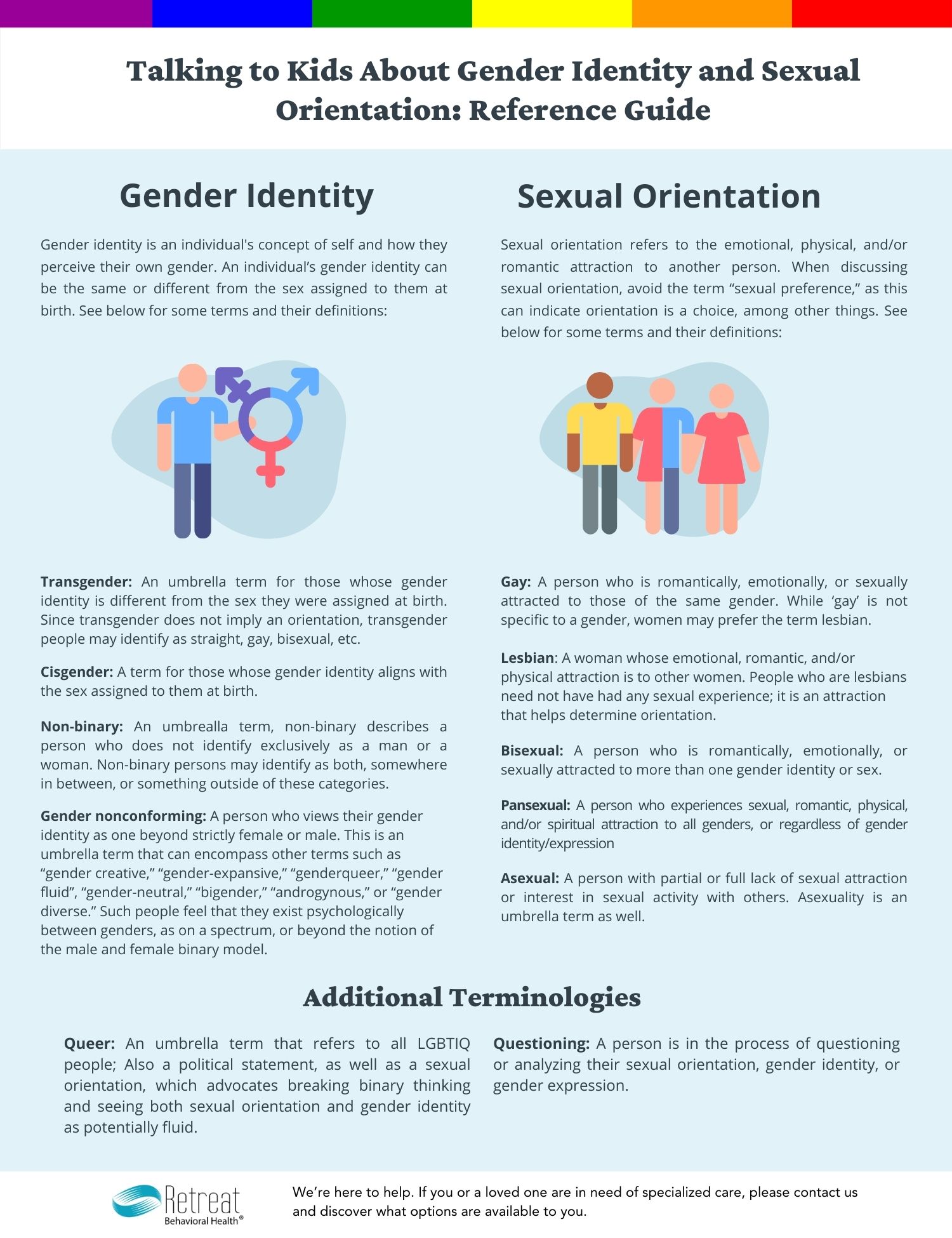When it comes to conversations around youth, sexuality and gender, today’s parents have a lot to consider beyond just the birds and the bees.
Kids have more access to information than ever before, and that can lead to overexposure to topics surrounding sexuality. But curiosity is part of childhood, and questions around things like gender identity and sexual orientation are completely normal. They’re also much easier to navigate when parents go in with a plan.
If you’re a parent who’s struggling to keep up, you’re not alone. Fortunately, there are a lot of resources that can be useful as you figure out how to broach topics related to youth and sexuality, and especially as your child starts to ask you some questions you may not know how to address.
Here’s why these conversations need to happen, plus some helpful tips and resources regarding specific definitions and more.

Why It’s Important to Talk to Kids About Sexuality
Kids talk. Whether it’s at school or on social media, your kid is almost certainly going to be exposed to topics around sexuality.
When you talk to your kids openly and honestly about topics like gender identity and sexual orientation, you do more than just clear up any confusion they might be having. These conversations help build trust in your household, and ensure your child is properly informed about things they’re likely to hear about. It also increases the chance that they feel safe with you, and safe coming to you with other important questions.
How to Talk to Your Child About Gender Identity and Sexual Orientation
The less sure you are of how to handle a conversation, the more you should prepare. Here are some things to keep in mind as you figure out how to talk to your child about gender identity, sexual orientation, and other topics related to youth and sexuality.
- Educate yourself – You can’t teach what you don’t know. Make sure you’ve got the basics down, and consider familiarizing yourself with demonstrations about sexual orientation and gender identity so you can answer appropriately, or at least in a more informed way.
- Ask your child what they know – Start the conversation by getting a feel for what your child already knows about the topic. This is a good jumping off point, and also a chance to learn if they have any misconceptions.
- No preaching – A conversation is not the same as a lecture. Keep opinions out of the equation if you can, aside from highlighting the importance of acceptance.
- Be an active listener – Don’t let it be a one-sided discussion. Listen in addition to talking, and let your child know that no questions are off limits.
- Be loving – Remaining loving and accepting is the ultimate tip for having this conversation (and others like it). Though this may be an unnerving conversation to have, it’s one that can have lasting impact on how a child sees themselves and others, and how they treat themselves and others.
Resources for Parents: Gender Identity vs. Sexual Orientation
Good conversations start with education. There are many resources explaining sexuality to children that may be helpful to you, but make sure to brush up on your own understanding too—including definitions of these main terms and those that fall within the umbrellas of each.
Gender Identity
Gender identity is an individual’s concept of self and how they perceive their gender, which includes male, female, a blend of the two, or neither. An individual’s gender identity can be the same or different from the sex assigned to them at birth. To give an example, a person who identifies as their biological sex is cisgender, while a person who identifies as a gender that is not the same as their biological sex is transgender.
Sexual Orientation
Sexual orientation refers to the emotional, physical, and/or romantic attraction to another person. A person may be straight (heterosexual), gay, lesbian, bisexual (attracted to more than one gender), asexual (a person who does not experience sexual attraction), and other orientations. When discussing sexual orientation, avoid the term “sexual preference,” as this can indicate orientation is a choice, among other things.
It’s also important to note that these terms often have variations that depend on an individual’s preferences, and we are only listing terminologies that are more widely heard. For supplemental information regarding both gender identity and sexual orientation, including a complete definitions guide and terms and labels to avoid, visit glaad.org or HRC.org or see our infographic below.

In need of additional resources? Gender Spectrum and KidsHealth.org are great places to look. Our team at Retreat Family is also available to provide support and has lots of tools that can help you navigate these conversations.
